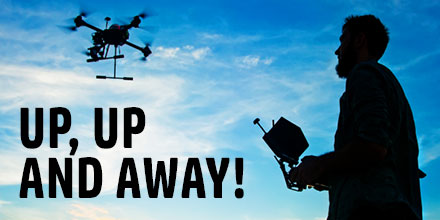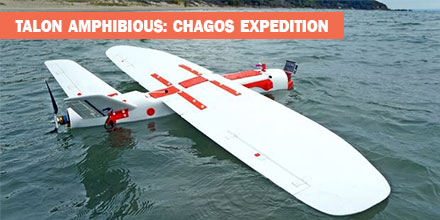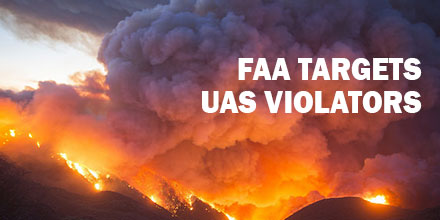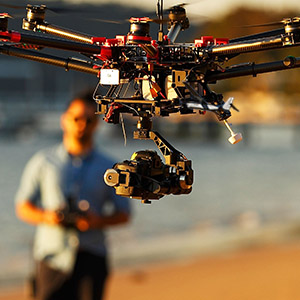Up, Up and Away!

A gust of wind. Interruption or loss of the control link. Pilot error. A dreaded flyaway.
There are many ways to lose a drone.
But when you think about the various hazards surrounding flight, outright loss may not come to mind. In fact, loss of a drone during flight is more common than you may think.
Of course, today’s drones are more and more automated and most come equipped with GPS. But that doesn’t mean things can’t and don’t go wrong…because they do. In the event of a catastrophe, the odds of finding your drone improve based on the steps you take
before such an event occurs.
Register your drone with the manufacturer
There are two basic camps when it comes to registering product with the manufacturer: those who automatically do it and those who consider it a waste of time.
Don’t neglect this step; there are many benefits to registering your drone. Some benefits include: proof of ownership, more efficient warranty services, product updates and recalls, and more. The minute you unpack your new vehicle, take the time to register it with the manufacturer.
If your drone flies away, some helpful individual may contact the manufacturer and help reunite you with your drone.
Register your drone with the FAA
As you know, as of December 21, 2015, the FAA requires all drones, model aircraft and other sUAS weighing between 0.55 and 55 pounds to be registered. You must register before your first flight.
Registering your drone with the FAA is inexpensive, easy and it can save you from getting hefty fines.
Update your drone’s GPS
If your drone has a GPS, power it up in a place that gives clear view of the sky and give the GPS time to update. Updates are automatically sent from the satellites. This step usually takes about 15 minutes but is well worth your time. Updated GPS helps ensure that in the event you need the drone to “return home” it has accurate positioning.
Tag it with a tracker
GPS-based trackers are an inexpensive and popular option. GPS trackers provide accurate positioning details of a lost drone. In the event your drone flies away, information on the longitude and latitude of its location helps you zero in on, at the very least, your search area. There are several trackers available on the market today, each with their own pluses and minuses.
Tag is with your number
It might not sound very tech savvy but putting your phone number on your drone is helpful. Consider this, if your drone flies off into the sunset, eventually, it comes crashing to the ground. There’s a chance some unsuspecting individual finds it, “Oh look, a lost drone!”
If your phone number is taped somewhere on the drone, this good Samaritan may just give you a call. Low-tech but effective.
Of course, it is always advisable for new flyers to grow their skills in open fields, away from obstructions and innocent bystanders. Keeping the drone within line of sight is also vital. Remember to fly with fully charged batteries and return home before the battery is completely drained.
Read more helpful tips for first time drone operators.
If you find a drone
If you happen to find a lost drone, there are a few steps you can take to help reunite the little buddy with his fretful owner.
One option is to locate the serial number, call the manufacture and report it “found”. If the manufacturer is able to help, they’ll outline next steps.
If the drone has a camera you can attempt to use the feed to communicate with the owner, which likely goes to their computer or mobile device. A shot of the phone number where the owner can contact you, is one suggestion.
Place an ad on Craigslist. It might seem unlikely but an ad could help you find the rightful owner.
And, of course, if the owner placed his number on the drone, simply give him or her a call.
In the event you experience a dreaded flyaway or simply lose your drone somewhere over the rainbow, consider the proactive steps listed above. Of course, there are no guarantees but the steps outlined may just help you get your drone back.
 In May 2018, an expedition to the British Indian Ocean Territory launched to study the distribution of megafauna across the Chagos Archipelago. Melissa Schiele, MSc student from Imperial College London, joined the expedition. Schiele also brought an amphibious drone -- the Aeromapper Talon -- to conduct the surveys.
"I was thrilled when Dr. Tom Letessier from Zoological Society of London (ZSL) chose me to help with his drone research as part of the Bertarelli Programme in Marine Science," said Schiele. "Our plan was to survey some of the islands of the Chagos Archipelago to compare distributions of megafauna around islands with nesting birds to islands with invasive rats."
To accomplish this task, Schiele researched possible drones.
"To our knowledge, no one had a fixed-wing water landing drone," said Schiele.
Fortunately for Schiele, there was one such drone that fit the bill -- the amphibious Aeromapper Talon manufactured by Aeromao Inc.
In May 2018, an expedition to the British Indian Ocean Territory launched to study the distribution of megafauna across the Chagos Archipelago. Melissa Schiele, MSc student from Imperial College London, joined the expedition. Schiele also brought an amphibious drone -- the Aeromapper Talon -- to conduct the surveys.
"I was thrilled when Dr. Tom Letessier from Zoological Society of London (ZSL) chose me to help with his drone research as part of the Bertarelli Programme in Marine Science," said Schiele. "Our plan was to survey some of the islands of the Chagos Archipelago to compare distributions of megafauna around islands with nesting birds to islands with invasive rats."
To accomplish this task, Schiele researched possible drones.
"To our knowledge, no one had a fixed-wing water landing drone," said Schiele.
Fortunately for Schiele, there was one such drone that fit the bill -- the amphibious Aeromapper Talon manufactured by Aeromao Inc.

 Pilots of unmanned aircraft who interfere with first responder efforts are now more likely to face serious civil penalties...even for first time offenses.
Recently, the
Pilots of unmanned aircraft who interfere with first responder efforts are now more likely to face serious civil penalties...even for first time offenses.
Recently, the  January 30, 2017 - uAvionix Corporation based in Palo Alto, California continues to innovate within the ADS-B transceiver market.
Today, uAvionix announced the development and test of a dime-sized transceiver weighing less than 1 gram.
UAvionix worked under a Collaborative Research and Development Agreement with the FAA and other partners to test this prototype.
January 30, 2017 - uAvionix Corporation based in Palo Alto, California continues to innovate within the ADS-B transceiver market.
Today, uAvionix announced the development and test of a dime-sized transceiver weighing less than 1 gram.
UAvionix worked under a Collaborative Research and Development Agreement with the FAA and other partners to test this prototype.
 A gust of wind. Interruption or loss of the control link. Pilot error. A dreaded flyaway.
There are many ways to lose a drone.
But when you think about the various hazards surrounding flight, outright loss may not come to mind. In fact, loss of a drone during flight is more common than you may think.
Of course, today’s drones are more and more automated and most come equipped with GPS. But that doesn’t mean things can’t and don’t go wrong…because they do. In the event of a catastrophe, the odds of finding your drone improve based on the steps you take before such an event occurs.
A gust of wind. Interruption or loss of the control link. Pilot error. A dreaded flyaway.
There are many ways to lose a drone.
But when you think about the various hazards surrounding flight, outright loss may not come to mind. In fact, loss of a drone during flight is more common than you may think.
Of course, today’s drones are more and more automated and most come equipped with GPS. But that doesn’t mean things can’t and don’t go wrong…because they do. In the event of a catastrophe, the odds of finding your drone improve based on the steps you take before such an event occurs.
 WASHINGTON —
WASHINGTON — 